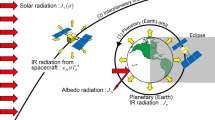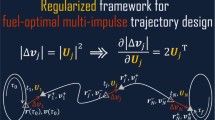Abstract
With an increasing number of missions planned to cislunar space, on-orbit servicing, inspection, and docking in a multi-body environment will need to take place in highly perturbed orbits for the first time. Thus, the investigation of these relative motion trajectories between two spacecraft is critical to successfully performing rendezvous and proximity operations in a multi-body environment. In this work, mass- and time-optimal trajectories are generated for a low-thrust chaser spacecraft entering into natural and forced loiter sequences about a target on a near rectilinear halo orbit. Constraints on the allowable region for safe rendezvous and proximity operations are applied to investigate the effects on feasible loitering maneuvers. Fuel costs are compared for transfers to both forced and natural loitering trajectories to determine the propellant reduction from leveraging the relative dynamics of NRHO manifolds.




















Similar content being viewed by others
Data availability
The data from this work is available upon request from the authors.
References
Smith, M. et al.: The Artemis program: an overview of NASA’s activities to return humans to the moon. IEEE Aerospace Conference 1–10 (2020). https://doi.org/10.1109/AERO47225.2020.9172323
Franzini, G., Innocenti, M.: Relative motion dynamics in the restricted three-body problem. J. Spacecr. Rocket. 56(5), 1322–1337 (2019). https://doi.org/10.2514/1.A34390
Human Landing System Concept of Operations: Tech. Rep, National Aeronautics and Space Administration (2019)
Innocenti, M., D’onofrio, F., Bucchioni, G.: Failure mitigation during rendezvous in cislunar orbit. AIAA Sci. Technol. Forum Expos. 2022, 1–19 (2022). https://doi.org/10.2514/6.2022-0861
Khoury, F., Howell, K. C.: Orbital rendezvous and spacecraft loitering in the earth-moon system. AAS/AIAA Astrodynamics Specialist Conference, pp. 1–20 (2020)
Topputo, F., Zhang, C.: Survey of direct transcription for low-thrust space trajectory optimization with applications. Abstr. Appl. Anal. (2014). https://doi.org/10.1155/2014/851720
Grebow, D.J.: Generating periodic orbits in the circular restricted three-body problem with applications to lunar south pole coverage. Ph.D. thesis, Purdue University (2006)
Bucci, L., Lavanga, M., Renk, F.: Relative dynamics analysis and rendezvous techniques for lunar near rectilinear halo orbits. Proceedings of 68th International Astronautical Congress (2017)
Straight, S.D.: Maneuver design for fast satellite circumnavigation. Ph.D. thesis, Air Force Institutde of Technology (2004)
Pezent, J.B., et al.: ASSET: astrodynamics software and science enabling toolkit. AIAA Sci. Technol. Forum Expos. 2022, 1–20 (2022). https://doi.org/10.2514/6.2022-1131
Colombi, F., Colagrossi, A., Lavagna, M.: Characterisation of 6DOF natural and controlled relative dynamics in cislunar space. Acta Astronaut. 196(2021), 369–379 (2022). https://doi.org/10.1016/j.actaastro.2021.01.017
Duchemin, O. et al.: Performance and lifetime predictions by testing and modeling for the PPS®5000 hall thruster. In: 39th AIAA/ASME/SAE/ASEE joint propulsion conference and exhibit, 1–8 (2003). https://doi.org/10.2514/6.2003-4555
Davis, D.C., Boudad, K.K., Power, R.J., Howell, K.C.: Heliocentric Escape and Lunar Impact from Near Rectilinear Halo Orbits, vol. 171. Portland, Maine (2019)
Davis, D.C., et al.: Orbit maintenance and navigation of human spacecraft at cislunar near rectilinear halo orbits. Adv. Astronaut. Sci. 160, 2257–2276 (2017)
Zimovan-Spreen, E.M., Howell, K.C., Davis, D.C.: Near rectilinear halo orbits and nearby higher-period dynamical structures: orbital stability and resonance properties. Celest. Mech. Dyn. Astron. 132(5), 1–25 (2020). https://doi.org/10.1007/s10569-020-09968-2
Mccarthy, B.: Cislunar trajectory design methodologies incorporating quasi-periodic structures with applications. Ph.D. thesis, Purdue University (2022). https://engineering.purdue.edu/people/kathleen.howell.1/Publications/dissertations/2022_McCarthy.pdf
Bennett, T., Schaub, H., Roscoe, C.W.: Faster-than-natural spacecraft circumnavigation via way points. Acta Astronaut. 123, 376–386 (2016). https://doi.org/10.1016/j.actaastro.2016.01.025
Acknowledgements
The first author would like to acknowledge the support of the National Science Foundation under Grant No. 2038237. Any opinions, findings, and conclusions or recommendations expressed in this material are those of the authors and do not necessarily reflect the views of the National Science Foundation. The author would also like to acknowledge the support of NASA under ROSES Grant No. 80NSSC19K1643.
Author information
Authors and Affiliations
Corresponding author
Ethics declarations
Conflict of interest
On behalf of all authors, the corresponding author states that there is no conflict of interest.
Additional information
Publisher's Note
Springer Nature remains neutral with regard to jurisdictional claims in published maps and institutional affiliations.
A previous version of this paper was presented at the 2023 AAS/AIAA Space Flight Mechanics Meeting (AAS 23-296).
Rights and permissions
Springer Nature or its licensor (e.g. a society or other partner) holds exclusive rights to this article under a publishing agreement with the author(s) or other rightsholder(s); author self-archiving of the accepted manuscript version of this article is solely governed by the terms of such publishing agreement and applicable law.
About this article
Cite this article
Sandel, C., Sood, R. Natural and Forced Spacecraft Loitering in a Near Rectilinear Halo Orbit. J Astronaut Sci 71, 28 (2024). https://doi.org/10.1007/s40295-024-00446-7
Accepted:
Published:
DOI: https://doi.org/10.1007/s40295-024-00446-7




